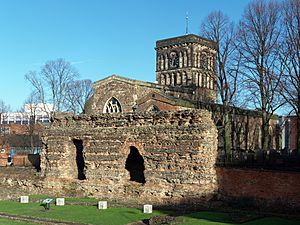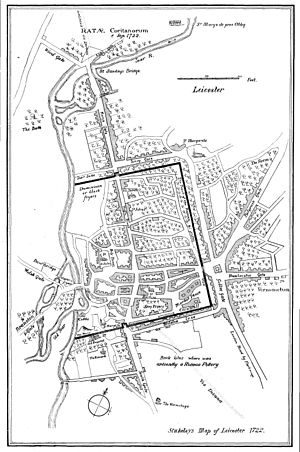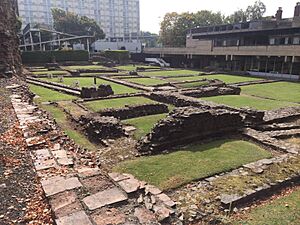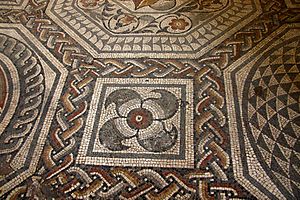Ratae Corieltauvorum facts for kids

Ratae Corieltauvorum, or simply Ratae, was an important town in Roman Britain. Today, we know this place as Leicester in England. It was the main city for a Celtic tribe called the Corieltauvi.
Contents
What's in a Name?
The name Ratae comes from a very old British word for "ramparts." Ramparts were like big walls or banks of earth used for defense. This suggests that the area was an ancient Iron Age settlement with defenses.
The full name, "Ratae Corieltauvorum," means "Ratae of the Corieltauvi." The Corieltauvi were a Celtic tribe who lived in this part of Britain. Ratae became their main city under Roman rule.
For a long time, people thought the name was "Ratae Coritanorum." But in 1983, an old stone inscription was found. It showed that the correct name was "Corieltauvorum."
History of Ratae
Early Settlement Before the Romans
Before the Romans arrived, a native British settlement grew here. This was around 200 or 100 years before Christ. The area had two parts of the River Soar: a main river and a smaller channel. There was likely a marshy island between them. The settlement probably controlled a place where people could cross the main river.
Roman Times: How Ratae Grew
Romans Arrive and Build Roads
The Romans invaded Britain in the 1st century AD. They quickly took control of the southeast. But for many years, they did not move further north or west. They built two large army bases. One was at Isca (now Exeter) in the southwest. The other was at Lindum (now Lincoln) in the northeast.
To connect these bases and control the area, the Romans built a major road. This road is now called the Fosse Way. The Fosse Way crossed the River Soar very close to the British settlement. It was a perfect spot for a Roman fort. However, archaeologists have found very little proof of a fort there. They found only one V-shaped ditch, which might have been part of a military camp.
Developing a Roman Town
Starting in 2016, new digs have found amazing things. They uncovered fancy, decorated houses in the center of Ratae. These houses had walls painted in many colors and patterns. They also had beautiful mosaic floors. Mosaics are pictures made from tiny pieces of stone or glass.
Earlier digs showed that Ratae first had a simple open market. But in the early 100s AD, better stone houses were built. These houses had central courtyards. One amazing house found had mosaic floors and decorated plaster walls. It also had a detailed frieze around its courtyard. This frieze showed theater masks, doves, and flowers.
This fancy house was not used for long. Part of it became a factory for making things from animal horns. Other businesses in Ratae included making pottery, working with metal, and making glass.
Later, the Romans built a proper forum and a basilica. A forum was a public square, and a basilica was a large public building. Public baths were also built around 145 AD. These baths had an aqueduct to bring in water. An aqueduct is like a bridge or channel that carries water. The baths also had a large exercise area. In the early 200s AD, a second market was created with a market hall.
By the end of the 200s AD, Ratae was surrounded by strong stone walls. There were four gates, and outside each gate were cemeteries. There was also a small neighborhood to the north. Only two possible temples have been found in Ratae. One might have been a Mithraeum, a temple for the god Mithras.
After the Romans: Medieval Times
In the late 300s AD, Roman soldiers were stationed in Ratae. Towers might have been added to the town walls. But a big fire swept through the town center. The forum, basilica, and market hall were never rebuilt.
After the Romans left Britain, not much is known about Ratae. But some people still lived in the town in the 400s and 500s AD.
What's Left Today?
The Roman name "Ratae" is still used today. You can find it in the names of clubs and groups in modern Leicester. For example, there's the Ratae Co-Operative Players (a drama group) and the Ratae Road Club (a cycling group).
You can also see physical remains from Roman Ratae:
- The Jewry Wall: This is a large wall that was part of the public baths.
- Raw Dykes: These are earthworks that people think are the remains of an aqueduct.
- St Nicholas' Church: This church was built using many old Roman building materials.
- The Jewry Wall Museum: This museum in Leicester has a large collection of items found from Roman Ratae.
See also
 In Spanish: Ratae Corieltauvorum para niños
In Spanish: Ratae Corieltauvorum para niños





